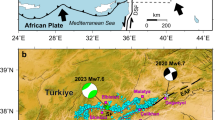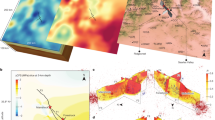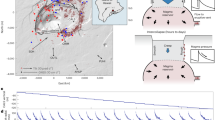Abstract
Earthquake hazard assessments and rupture forecasts are based on the potential length of seismic rupture and whether or not slip is arrested at fault segment boundaries. Such forecasts do not generally consider that one earthquake can trigger a second large event, near-instantaneously, at distances greater than a few kilometres. Here we present a geodetic and seismological analysis of a magnitude 7.1 intracontinental earthquake that occurred in Pakistan in 1997. We find that the earthquake, rather than a single event as hitherto assumed, was in fact an earthquake doublet: initial rupture on a shallow, blind reverse fault was followed just 19 s later by a second rupture on a separate reverse fault 50 km away. Slip on the second fault increased the total seismic moment by half, and doubled both the combined event duration and the area of maximum ground shaking. We infer that static Coulomb stresses at the initiation location of the second earthquake were probably reduced as a result of the first. Instead, we suggest that a dynamic triggering mechanism is likely, although the responsible seismic wave phase is unclear. Our results expose a flaw in earthquake rupture forecasts that disregard cascading, multiple-fault ruptures of this type.
This is a preview of subscription content, access via your institution
Access options
Subscribe to this journal
Receive 12 print issues and online access
$259.00 per year
only $21.58 per issue
Buy this article
- Purchase on Springer Link
- Instant access to full article PDF
Prices may be subject to local taxes which are calculated during checkout




Similar content being viewed by others
References
Wesnousky, S. G. Predicting the endpoints of earthquake ruptures. Nature 444, 358–360 (2006).
Wesnousky, S. G. Displacement and geometrical characteristics of earthquake surface ruptures: issues and implications for seismic-hazard analysis and the process of earthquake rupture. Bull. Seismol. Soc. Am. 98, 1609–1632 (2008).
Field, E. H. et al. Uniform California earthquake rupture forecast, version 3 (UCERF3)—the time-independent model. Bull. Seismol. Soc. Am. 104, 1122–1180 (2014).
Page, M. T., Field, E. H., Milner, K. R. & Powers, P. M. The UCERF3 grand inversion: solving for the long-term rate of ruptures in a fault system. Bull. Seismol. Soc. Am. 104, 1181–1204 (2014).
Ambraseys, N. & Bilham, R. Earthquakes and associated deformation in northern Baluchistan 1892–2001. Bull. Seismol. Soc. Am. 93, 1573–1605 (2003).
Nakata, T., Otsuki, K. & Khan, S. H. Active faults, stress field and plate motion along the Indo-Eurasian plate boundary. Tectonophysics 181, 83–95 (1990).
Haq, S. S. & Davis, D. M. Oblique convergence and the lobate mountain belts of western Pakistan. Geology 25, 23–26 (1997).
Sarwar, G. & DeJong, K. A. Geodynamics of Pakistan 351–358 (Geological Survey of Pakistan, 1979).
Banks, C. J. & Warburton, J. ‘Passive-roof’ duplex geometry in the frontal structures of the Kirthar and Sulaiman mountain belts, Pakistan. J. Struct. Geol. 8, 229–237 (1986).
Humayon, M., Lillie, R. J. & Lawrence, R. D. Structural interpretation of the eastern Sulaiman foldbelt and foredeep, Pakistan. Tectonics 10, 299–324 (1991).
Davis, D. M. & Lillie, R. J. Changing mechanical response during continental collision: active examples from the foreland thrust belts of Pakistan. J. Struct. Geol. 16, 21–34 (1994).
Jadoon, I. A., Lawrence, R. D. & Shahid Hassan, K. Mari-Bugti pop-up zone in the central Sulaiman fold belt, Pakistan. J. Struct. Geol. 16, 147–158 (1994).
Bernard, M., Shen-Tu, B., Holt, W. E. & Davis, D. M. Kinematics of active deformation in the Sulaiman Lobe and Range, Pakistan. J. Geophys. Res. 105, 13253–13279 (2000).
Copley, A. The formation of mountain range curvature by gravitational spreading. Earth Planet. Sci. Lett. 351, 208–214 (2012).
Reynolds, K., Copley, A. & Hussain, E. Evolution and dynamics of a fold-thrust belt: the Sulaiman Range of Pakistan. Geophys. J. Int. 201, 683–710 (2015).
Macedo, J. & Marshak, S. Controls on the geometry of fold-thrust belt salients. Geol. Soc. Am. Bull. 111, 1808–1822 (1999).
Wright, T. J., Lu, Z. & Wicks, C. Source model for the Mw 6.7, 23 October 2002, Nenana Mountain Earthquake (Alaska) from InSAR. Geophys. Res. Lett. 30, 1974 (2003).
Funning, G. J., Parsons, B., Wright, T. J., Jackson, J. A. & Fielding, E. J. Surface displacements and source parameters of the 2003 Bam (Iran) earthquake from Envisat advanced synthetic aperture radar imagery. J. Geophys. Res. 110, B09406 (2005).
Talebian, M. & Jackson, J. A reappraisal of earthquake focal mechanisms and active shortening in the Zagros mountains of Iran. Geophys. J. Int. 156, 506–526 (2004).
Nissen, E., Tatar, M., Jackson, J. A. & Allen, M. B. New views on earthquake faulting in the Zagros fold-and-thrust belt of Iran. Geophys. J. Int. 186, 928–944 (2011).
Satyabala, S. P., Yang, Z. & Bilham, R. Stick-slip advance of the Kohat Plateau in Pakistan. Nature Geosci. 5, 147–150 (2012).
Copley, A. & Reynolds, K. Imaging topographic growth by long-lived postseismic afterslip at Sefidabeh, east Iran. Tectonics 33, 330–345 (2014).
Ritzwoller, M. H., Shapiro, N. M., Levshin, A. L., Bergman, E. A. & Engdahl, E. R. Ability of a global three-dimensional model to locate regional events. J. Geophys. Res. 108, 2353 (2003).
Walker, R. T., Bergman, E. A., Szeliga, W. & Fielding, E. J. Insights into the 1968–1997 Dasht-e-Bayaz and Zirkuh earthquake sequences, eastern Iran, from calibrated relocations, InSAR and high-resolution satellite imagery. Geophys. J. Int. 187, 1577–1603 (2011).
Szeliga, W. M. Historical and Modern Seismotectonics of the Indian Plate with an Emphasis on its Western Boundary with the Eurasian Plate PhD thesis, Univ. Colorado (2010).
Pezzo, G., Boncori, J. P. M., Atzori, S., Antonioli, A. & Salvi, S. Deformation of the western Indian Plate boundary: insights from differential and multi-aperture InSAR data inversion for the 2008 Baluchistan (Western Pakistan) seismic sequence. Geophys. J. Int. 198, 25–39 (2014).
Pinel-Puysségur, B., Grandin, R., Bollinger, L. & Baudry, C. Multifaulting in a tectonic syntaxis revealed by InSAR: the case of the Ziarat earthquake sequence (Pakistan). J. Geophys. Res. 119, 5838–5854 (2014).
Molnar, P. & Lyon-Caen, H. Fault plane solutions of earthquakes and active tectonics of the Tibetan Plateau and its margins. Geophys. J. Int. 99, 123–154 (1989).
Ishii, M., Shearer, P. M., Houston, H. & Vidale, J. E. Extent, duration and speed of the 2004 Sumatra–Andaman earthquake imaged by the Hi-Net array. Nature 435, 933–936 (2005).
Trabant, C. et al. Data products at the IRIS DMC: stepping-stones for research and other applications. Seismol. Res. Lett. 83, 846–854 (2012).
Stein, R. S. The role of stress transfer in earthquake occurrence. Nature 402, 605–609 (1999).
Lin, J. & Stein, R. S. Stress triggering in thrust and subduction earthquakes and stress interaction between the southern San Andreas and nearby thrust and strike-slip faults. J. Geophys. Res. 109, B02303 (2004).
Tibi, R., Wiens, D. A. & Inoue, H. Remote triggering of deep earthquakes in the 2002 Tonga sequences. Nature 424, 921–925 (2003).
Hill, D. P. et al. Seismicity remotely triggered by the magnitude 7.3 Landers, California, earthquake. Science 260, 1617–1623 (1993).
Velasco, A. A., Hernandez, S., Parsons, T. & Pankow, K. Global ubiquity of dynamic earthquake triggering. Nature Geosci. 1, 375–379 (2008).
Pollitz, F. F., Stein, R. S., Sevilgen, V. & Bürgmann, R. The 11 April 2012 east Indian Ocean earthquake triggered large aftershocks worldwide. Nature 490, 250–253 (2012).
Lin, C. H. Remote triggering of the Mw 6.9 Hokkaido Earthquake as a result of the Mw 6.6 Indonesian earthquake on September 11, 2008. Terr. Atmos. Ocean. Sci. 23, 283–290 (2012).
Voisin, C., Campillo, M., Ionescu, I. R., Cotton, F. & Scotti, O. Dynamic versus static stress triggering and friction parameters: inferences from the November 23, 1980, Irpinia earthquake. J. Geophys. Res. 105, 21647–21659 (2000).
Felzer, K. R. & Brodsky, E. E. Decay of aftershock density with distance indicates triggering by dynamic stress. Nature 441, 735–738 (2006).
Decriem, J. et al. The 2008 May 29 earthquake doublet in SW Iceland. Geophys. J. Int. 181, 1128–1146 (2010).
Richards-Dinger, K., Stein, R. S. & Toda, S. Decay of aftershock density with distance does not indicate triggering by dynamic stress. Nature 467, 583–586 (2010).
Gomberg, J., Bodin, P. & Reasenberg, P. A. Observing earthquakes triggered in the near field by dynamic deformations. Bull. Seismol. Soc. Am. 93, 118–138 (2003).
Pollitz, F. F. & Johnston, M. J. Direct test of static stress versus dynamic stress triggering of aftershocks. Geophys. Res. Lett. 33, L15318 (2006).
Parsons, T. & Velasco, A. A. On near-source earthquake triggering. J. Geophys. Res. 114, B10307 (2009).
Harris, R. A. & Day, S. M. Dynamic 3D simulations of earthquakes on en echelon faults. Geophys. Res. Lett. 26, 2089–2092 (1999).
Rubin, C. M. Systematic underestimation of earthquake magnitudes from large intracontinental reverse faults: historical ruptures break across segment boundaries. Geology 24, 989–992 (1996).
Meng, L. et al. Earthquake in a maze: compressional rupture branching during the 2012 Mw 8.6 Sumatra earthquake. Science 337, 724–726 (2012).
Dolan, J. F. et al. Prospects for larger or more frequent earthquakes in the Los Angeles Metropolitan region. Science 267, 199–205 (1995).
Engdahl, E. R., van der Hilst, R. & Buland, R. Global teleseismic earthquake relocation with improved travel times and procedures for depth determination. Bull. Seismol. Soc. Am. 88, 722–743 (1998).
Argus, D. F. et al. The angular velocities of the plates and the velocity of Earth’s centre from space geodesy. Geophys. J. Int. 180, 913–960 (2010).
Acknowledgements
This work is supported by the UK Natural Environmental Research Council (NERC) through the Looking Inside the Continents project (NE/K011006/1), the Earthquake without Frontiers project (EwF_NE/J02001X/1_1) and the Centre for the Observation and Modelling of Earthquakes, Volcanoes and Tectonics (COMET). The Incorporated Research Institutions for Seismology (IRIS) Data Management Center is funded through the Seismological Facilities for the Advancement of Geoscience and EarthScope (SAGE) Proposal of the National Science Foundation (EAR-1261681). We are grateful to E. Bergman for guidance in earthquake relocations, and K. McMullan and A. Rickerby for their assistance with preliminary InSAR and body waveform modelling.
Author information
Authors and Affiliations
Contributions
InSAR analysis and accompanying Coulomb modelling were undertaken by E.N. and J.R.E. Seismological analyses were led by R.A.S. (calibrated multi-event relocation), A.H. (seismic back-projection) and E.N. (body waveform modelling). All authors contributed to the interpretation of results and E.N. wrote the manuscript.
Corresponding author
Ethics declarations
Competing interests
The authors declare no competing financial interests.
Supplementary information
Supplementary Information
Supplementary Information (PDF 3276 kb)
Supplementary Movies
Supplementary Movie 1 (MOV 62 kb)
Supplementary Movies
Supplementary Movie 2 (MOV 62 kb)
Rights and permissions
About this article
Cite this article
Nissen, E., Elliott, J., Sloan, R. et al. Limitations of rupture forecasting exposed by instantaneously triggered earthquake doublet. Nature Geosci 9, 330–336 (2016). https://doi.org/10.1038/ngeo2653
Received:
Accepted:
Published:
Issue Date:
DOI: https://doi.org/10.1038/ngeo2653
This article is cited by
-
Dense geophysical observations reveal a triggered, concurrent multi-fault rupture at the Mendocino Triple Junction
Communications Earth & Environment (2023)
-
Source study of 2017 Hojedk triplet earthquake sequence, southeast Iran
Journal of Seismology (2021)
-
Paleoseismology of the western Sürgü–Misis fault system: East Anatolian Fault, Turkey
Mediterranean Geoscience Reviews (2020)
-
Locking on a megathrust as a cause of distributed faulting and fault-jumping earthquakes
Nature Geoscience (2018)
-
The role of space-based observation in understanding and responding to active tectonics and earthquakes
Nature Communications (2016)



